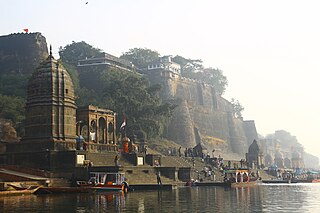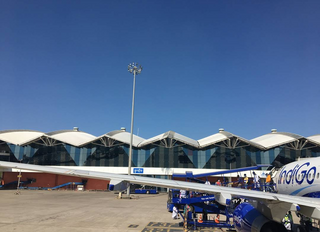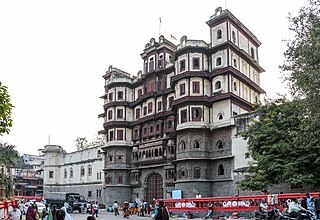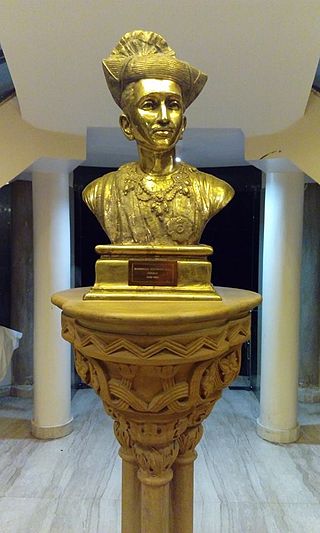
Madhya Pradesh is a state in central India. Its capital is Bhopal, and the largest city is Indore, with Jabalpur, Ujjain, Gwalior, Sagar, Satna, Narmadapuram, Shahdol, Rewa and Morena being the other major cities. Madhya Pradesh is the second largest Indian state by area and the fifth largest state by population with over 72 million residents. It borders the states of Uttar Pradesh to the northeast, Chhattisgarh to the east, Maharashtra to the south, Gujarat to the west, and Rajasthan to the northwest.

Indore is the largest and most populous city in the Indian state of Madhya Pradesh. It is consistently ranked as the cleanest city in India. It serves as the headquarters of both the Indore District and the Indore Division. It is also considered as the state education hub and houses campuses of both the Indian Institute of Technology and the Indian Institute of Management. Located on the southern edge of Malwa Plateau, at an average altitude of 553 meters (1,814 ft) above sea level, it has the highest elevation among major cities of Central India. The city is 190 km (120 mi) west of the state capital of Bhopal. Indore had a census-estimated 2011 population of 1,994,397 and 3,570,295. The city is distributed over a land area of just 530 square kilometres (200 sq mi), making Indore the most densely populated major city in the central province.

Malwa is a historical region of west-central India occupying a plateau of volcanic origin. Geologically, the Malwa Plateau generally refers to the volcanic upland north of the Vindhya Range. Politically and administratively, it is also synonymous with the former state of Madhya Bharat which was later merged with Madhya Pradesh. At present the historical Malwa region includes districts of western Madhya Pradesh and parts of south-eastern Rajasthan. Sometimes the definition of Malwa is extended to include the Nimar region south of the Vindhyas.

Dewas is a city in the Malwa region of the Indian state of Madhya Pradesh. The municipality was formerly the seat of two 15-Gun Salute state princely states during the British Raj, Dewas Junior state and Dewas Senior state, ruled by the Puar clan of the Marathas. The city is the administrative capital of Dewas district. Dewas is an industrialised city and houses a government bank note press.

Maheshwar is a town, near Khargone city in Khargone district of Madhya Pradesh state, in central India. It is located on State Highway-38 ,13.5 km east of National Highway 3 and 91 km from Indore, the commercial capital of the state. The Town lies on the north bank of the Narmada River. It was the kingdom of Chaktavartin Samrat Sahastraarjun, Kartavirya Arjuna a Heheya king. Lately, after many years, it was the capital of the Malwa during the Maratha Holkar reign till 6 January 1818, when the capital was shifted to Indore by Malhar Rao Holkar III.

The Holkars were a dynasty of Maratha Confederacy of India. The Holkars were generals under Peshwa Baji Rao I, and later became Maharajas of Indore in Central India as an independent member of the Maratha Empire until 1818. Later, their kingdom became a princely state under the protectorate of British India.

Chhatri are semi-open, elevated, dome-shaped pavilions used as an element in Indo-Islamic architecture and Indian architecture. They are most commonly square, octagonal, and round. Originating as a canopy above tombs, they largely serve as decorative elements as opposed to functional elements. The earliest example of chhatri being used in the Indian Subcontinent were found in the Shrine of Ibrahim in Bhadreswar, constructed between 1159 and 1175 AD.

Ahilya Bai Holkar was the hereditary noble queen of the Maratha Empire, in early-modern India. She established Maheshwar as the seat of Holkar Dynasty.

The Indore District is a district of Madhya Pradesh state in central India. It is believed that the city is named after its Indreshwar Mahadev Temple, Where Indra is the presiding deity. The Gupta inscriptions name Indore as "Indrapura". It is also called the administrative capital. This district forms part of the Indore Division.

Malhar Rao Holkar was a noble subedar of the Maratha Empire, in present-day India. He was one of the early officers along with Ranoji Scindia to help spread the Maratha rule to northern states and was given the estate of Indore to rule by the Peshwas, during the reign of the Maratha emperor Shahu I. He was founder of the Holkar dynasty that ruled Malwa.
Barwaha is a municipality and tehsil in Khargone district in the state of Madhya Pradesh, India. Barwaha is second biggest city of District after Khargone city. The Barwaha city is divided into 18 wards for which elections are held every 5 years. The Barwaha Municipality has population of 39,973 of which 20,940 are males while 19,033 are females as per report released by Census India 2011. Literacy rate of Barwaha is 87.27% higher than state average of 69.32%. In Barwaha, Male literacy is around 92.73% while female literacy rate is 81.23%.

Devi Ahilya Bai Holkar Airport is an international airport serving the city of Indore, Madhya Pradesh, India. It is the busiest airport in Central India and is located 8 km (5.0 mi) west of Indore. According to the statistics released by the Airports Authority of India (AAI), the agency responsible for the maintenance and management of the airport, it was the 18th busiest airport in India by passenger traffic in the year 2018-19. The airport is named after Maharani Ahilya Bai Holkar of Indore, belonging to the Holkar dynasty of the Maratha Empire. Since 24 March 2018, it has started operations 24*7 with night landing facilities.

The history of Madhya Pradesh can be divided into three periods - the ancient period, the medieval period and modern period.

Rajwada, also known as the Holkar Palace or Old Palace, is an important historical palace in Indore that was constructed by the Holkars of the Maratha empire, around 2 centuries ago. An example of the fine architectural skill and magnificence of those times, the palace is an impressive 7 storey structure that is placed near the Holkar Chhatris. One of the popular tourist attractions of Indore, Rajwada Palace is one of the oldest structures too. The construction of the palace was started by Malhar Rao Holkar, the founder of Holkar Dynasty in the year 1747 A.D. This remarkable structure is placed in Khajuri Bazaar, right in the middle of the city. The Rajwada palace has the Shiv Vilas Palace on the right and faces a well-maintained garden that has a statue of Maharani Ahilya Bai Holkar, fountains and an artificial waterfall.
Alampur is a town and a nagar panchayat in Bhind district in the Indian state of Madhya Pradesh. Alampur is known for its history, for the chhatri of Malhar Rao Holkar which is in Alampur.
Kampel is a panchayat village in the Indore block of the Indore district, Madhya Pradesh, India. It was the headquarters of a pargana in Mughal Empire before the administrative center of the region was shifted to Indore city under the Holkars of the Maratha Empire. In this region mostly (Choudhary-Patel) Khati people live.

Hari Rao Holkar (1795-1843), formally Maharajadhiraj Raj Rajeshwar Sawai Shri Hari Rao Holkar IX Bahadur, belonging to the Holkar dynasty of the Marathas was Maharaja Holkar of Indore from 17 April 1834 until his death at the Juna Rajwada Palace in Indore on 24 October 1843. He was the grandson of Tukoji Rao Holkar.

Indore State, also known as Holkar State, was a kingdom in India. Its rulers belonged to the Holkar dynasty of Maratha Empire. After 1857, Indore became a 19-gun salute Maratha princely state under the British Raj.

The Yeshwant Club in Indore, Madhya Pradesh, India, came into existence in 1934 at the behest of Maharaja Sir Tukoji Rao III Holkar of Indore. The club was established out of affection for his son, Yuvraj Yeshwant Rao Holkar. Spread over an expanse of 14 acres, it is one of the living signatures of the rich legacy of the Holkar rulers of Indore State of the Maratha Confederacy. Initially the club was opened for royalty, nobility, aristocracy, and the officers of the Holkar State. Later, its doors were opened for business elites. After Indian independence, admission criteria were revised.

Khanderao Holkar was the only son of Malhar Rao Holkar, the founder of the Holkar dynasty of Indore, and Gautama Bai. He was the husband of Ahilyabai Holkar. He served as a Maratha Sardar and fought several campaigns on behest of the Maratha empire.



















